In my unbias opininon, disucs are the most beautiful fish in the world.
Especially a school of them.
No matter which type of discus you pick, you’re in for a treat. Here are my favorite types I’m excited to share with you.
Types of Tank Bred Discus Fish
Fish keepers have been selectively breeding discus for decades, trying to make them more and more colorful.
After untold generations of fish, there are now hundreds of color morphs that are so eye-catching it almost seems impossible. There’s just no way to cover them all in a single article.
Actually, I don’t know that you could cover them all in a single book comfortably!
So, I picked out some of the most popular to talk about, just know there are so many more out there!
1. Red Turquoise Discus
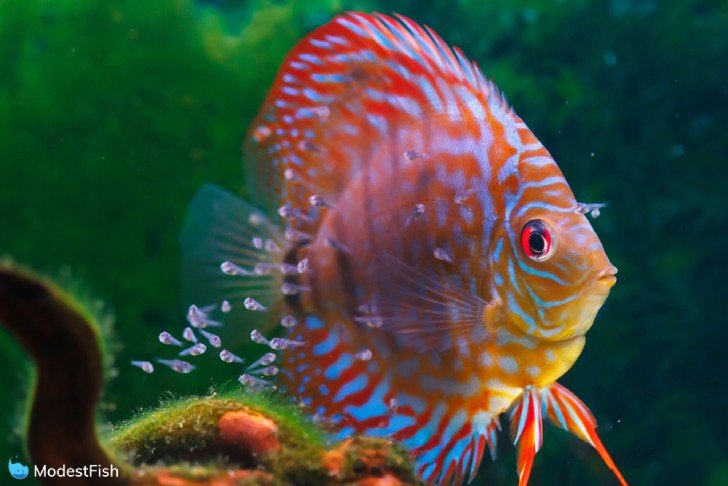
Red turquoise discus have a bright blood red base color that is broken up by metallic blue lines, squiggles and spots. The contrast between the two colors is just stunning. This species has the vertical striping typical of S. aequifasciatus.
2. Brilliant Turquoise Discus
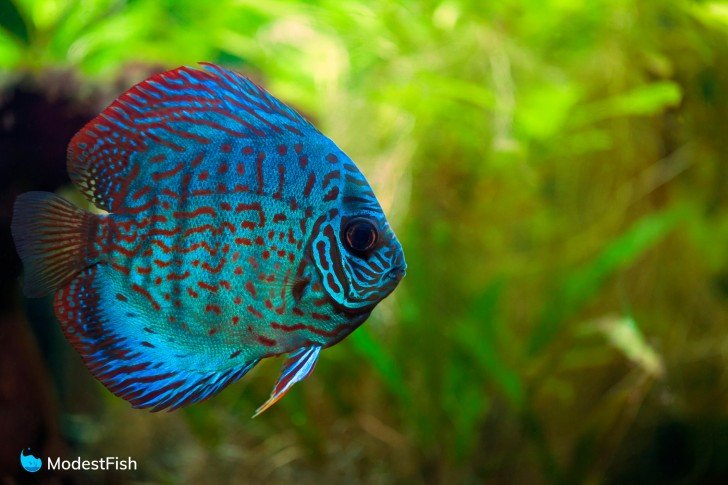
This variety is similar to the red turquoise, but instead of having the bright metallic red base color, their base color is more of a sunset orange. The turquoise striping is very dominant and covers most of their bodies. They have vertical stripes that show through, but they are very faint.
3. Pigeon Blood Discus
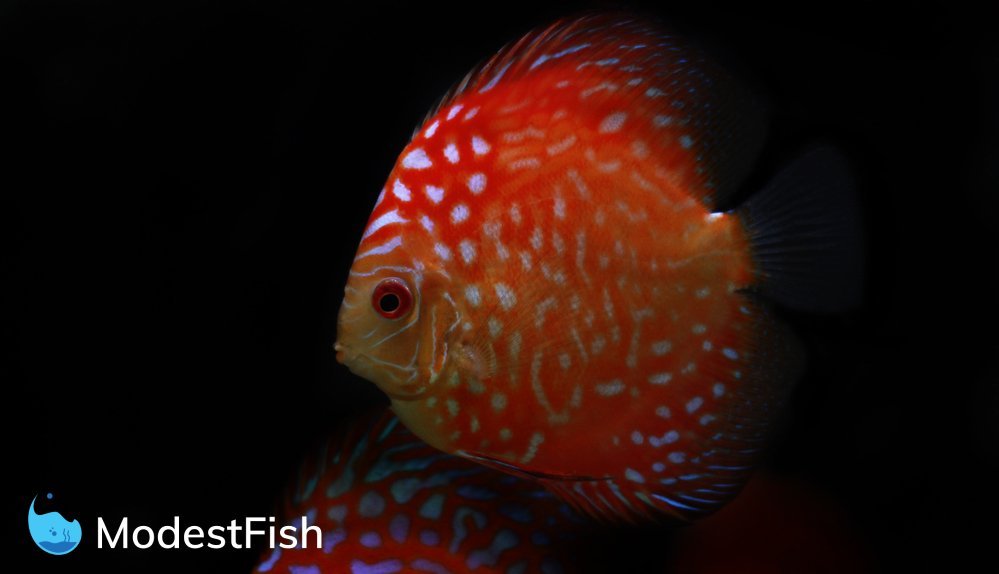
First bred in Thailand in the 1980s, this variety of discus is named for its dark red eyes, said to resemble ‘’pigeon blood’’ rubies that are popular in the region. This variety has a base color that’s a light orange color, kind of like a creamsicle. Over this is a honeycomb pattern of bright red that covers their whole body. Their vertical stripes really don’t show much and they usually have black tails.
4. Cobalt Discus

Have you ever looked at a fish that has metallic blue markings and thought, “It would be so cool if the whole fish looked like that?” Look no further than the cobalt discus. They are a rich royal blue with no vertical striping.
Their entire bodies have that metallic sheen that you usually only get glimpses of on other fish. Trust me, pictures do not do these guys justice. When they turn in the tank, the light catches their scales, and it’s just amazing.
5. Blue Diamond Discus
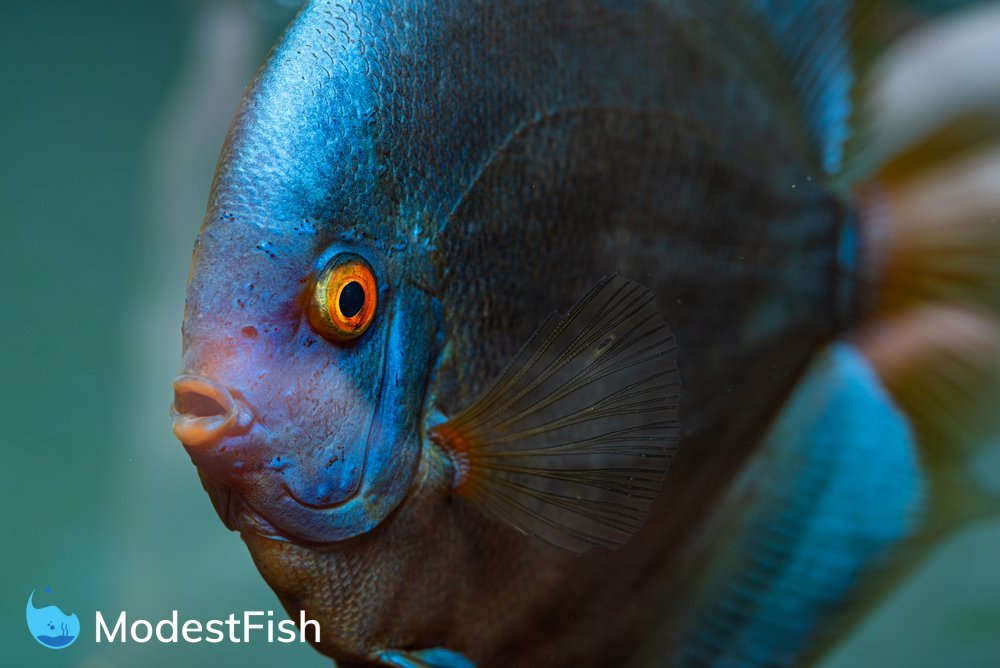
The blue diamond is another solid-colored fish, similar to the cobalt. But, instead of metallic blue, they’re a powder blue, similar to blue dwarf gouramis. I particularly like the contrast between their bright red eyes and the powder blue.
6. Snakeskin Discus
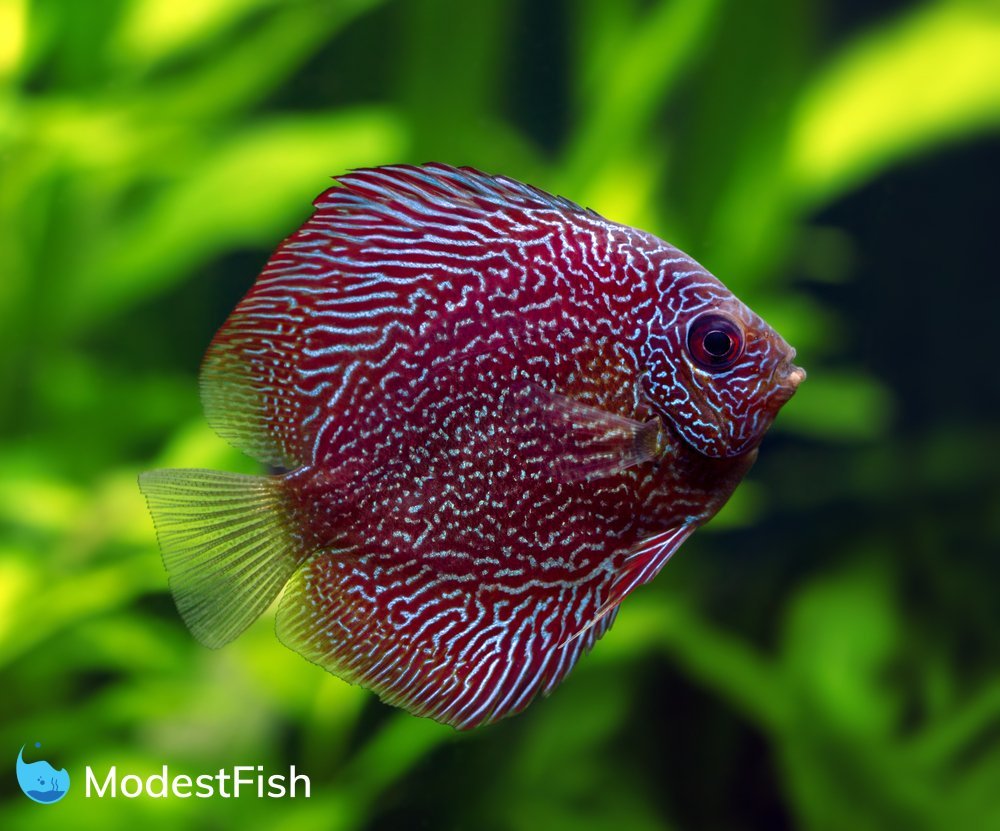
Snakeskin discus are really interesting. First off, snakeskin is more of a pattern than a set color combination. So, you’ll see things like ‘’blue snakeskin’’ or ‘’high-bodied red snakeskin.’’ Whatever the color combo, they’re set apart from other discus by their markings. Instead of stripes or squiggles, they have tiny, tightly packed spots all over their bodies. They also have 14 vertical stripes instead of nine.
7. Ring Leopard Discus
Ring leopard is also a pattern more than a color. I’ve seen ones with an almost white base color with red markings as well as red base color with turquoise markings. These beauties are some of the more expensive varieties available for sale these days. Their markings look like leopard print because they have large round spots that show the base color in the middle. They have nine very faint vertical stripes.
8. Marlboro Red Discus
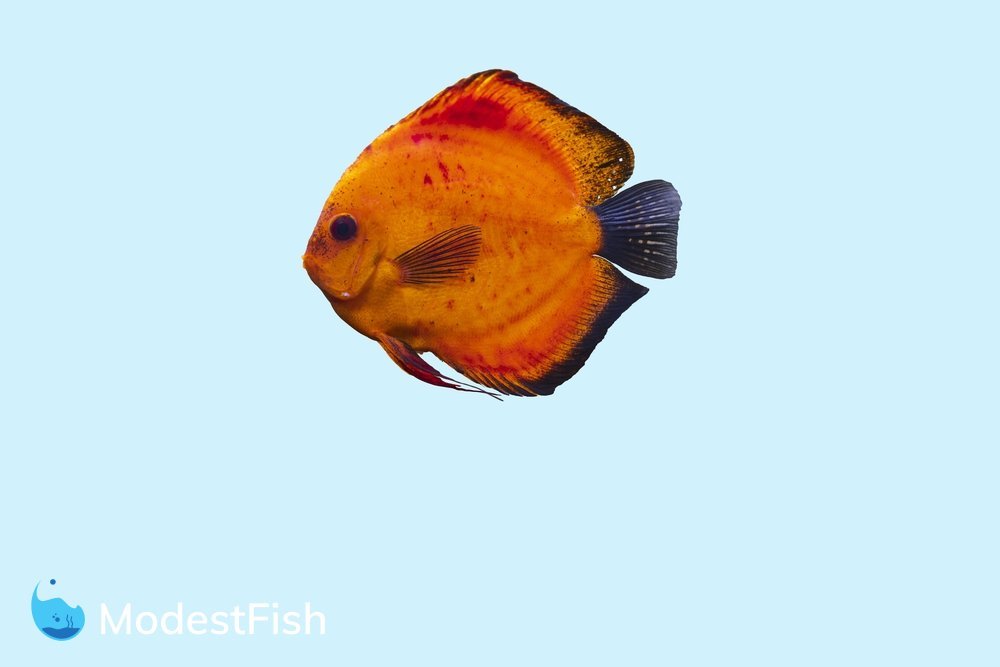
This is another solid-colored variety. They are bright blood red and most have a black tail. There are several variations: solid red, red with a white face, red with a yellow face, red with small patches of blue striping on the dorsal and anal fins.
9. Tangerine Discus
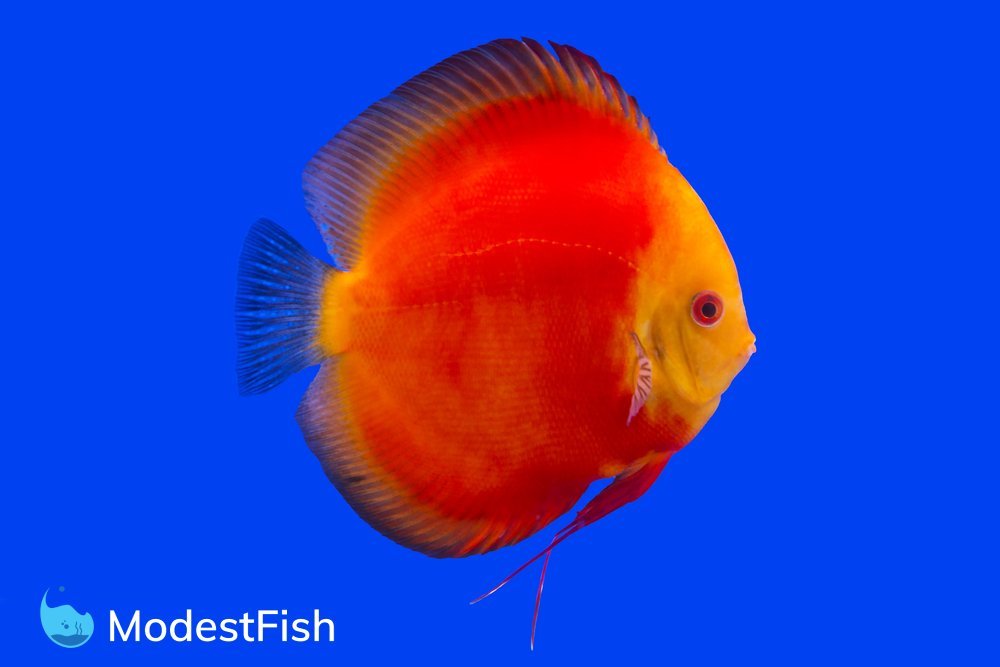
Tangerines are a solid orange color, similar to the creamsicle color that is the base color of pigeon blood discus. There are several color morphs under this heading. I think the prettiest are the ones with bright white markings on their faces and backs.
10. Checkerboard Discus
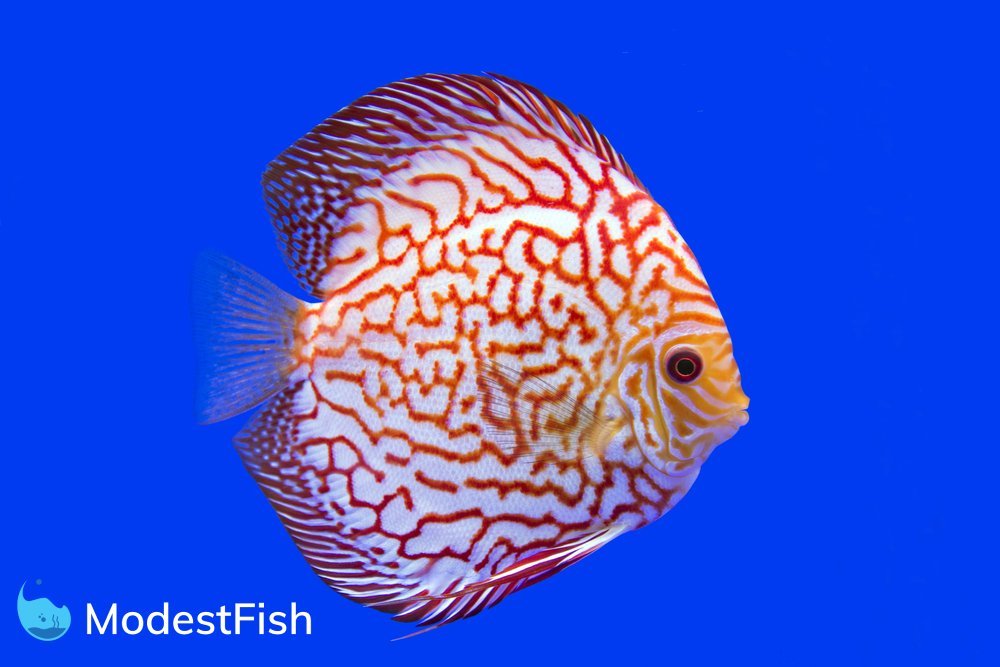
This variety has red markings over either a white or turquoise base color. This pattern is supposed to resemble a checkerboard, but frankly, I’ve always found that to be a pretty loose interpretation. The lines are by no means the perfect squares of an actual checkerboard. But, these fish are still absolutely gorgeous, no matter what name you give them.
The Discus Genus
Discus are large South American cichlids that are renowned for their beautiful colors, graceful swimming and peaceful temperaments.
They are a very laterally compressed fish, meaning they are broad when seen from their sides, but are very flat when seen head on. This lets them maneuver easily through thick vegetation and submerged tree roots in their native territory, the Amazon River basin.
Discus are considered to be the crown jewels of the freshwater aquarium hobby. Not only are they beautiful, but they are a demanding fish to take care of, so being able to keep them successfully is the mark of a great aquarist.
They are a sensitive fish that are quite timid. Despite being fairly large fish (8-9 inches 20-23 centimeters), they are easily frightened.
Wild Discus Species
There are three species of discus in nature. They make up the entirety of the genus Symphysodon.
Symphysodon discus
Known as the red discus, or the Heckel discus, this species is able to cross breed with one of the other discus species, S. aequifasciatus. S. dicus is native to the Rio Negro, a major tributary of the Amazon River.
These fish have a base color that’s sort of an orangish tan color. They have stripes of a lighter tan that run from nose to tail that become more blue in color as they reach the dorsal and anal fins.
They have nine vertical stripes on their sides. Six of these are a dark brown, but the first, sixth and ninth are a much bolder black color that really stands out.
Symphysodon aequifasciatus
Known as the blue discus or the brown discus, S. aequifasciatus is native to the eastern and central rivers of the Amazon River basin.
The wild form of this fish is often sold under the simple common name of “wild discus.” Their base color is a rich reddish brown. They also sport vertical stripes but each one is equally distinct. They can have some blue striping around their heads and on their dorsal and anal fins.
They also have thick black stripes on these fins which makes it look like they have a black rim around their bodies.
Symphysodon tarzoo
This species is known as the green discus or sometimes the red-spotted green discus. S. tarzoo cannot interbreed with either S. aequifasciatus or S. discus. S. tarzoo is native to the rivers in the western Amazon River basin.
This species has an olive green base color. They have nine stripes, the middle seven are somewhat faint, while the first and ninth stripes are much bolder. S. tarzoo have turquoise striping along their anal and dorsal fins as well as dark bands of black on both fins that forms a rim around their bodies.
Pro Tip: There is some debate about what the different discus species should be called. For more information about this, please see this article.
Which Discus Is Right For You?
No matter which variety you decide to go with, discus are some of the most beautiful fish in the world. In a lot of ways, I actually think they’re prettier than saltwater fish.
I love the graceful way they move around the tank, especially when they form a school and glide around the tank as a big group.
It’s easy to see why they’re considered the pinnacle of the freshwater aquarium world.
I hope you’ve enjoyed reading this article, I certainly know that I’ve enjoyed writing it!
I wish you and your fish the very best!
